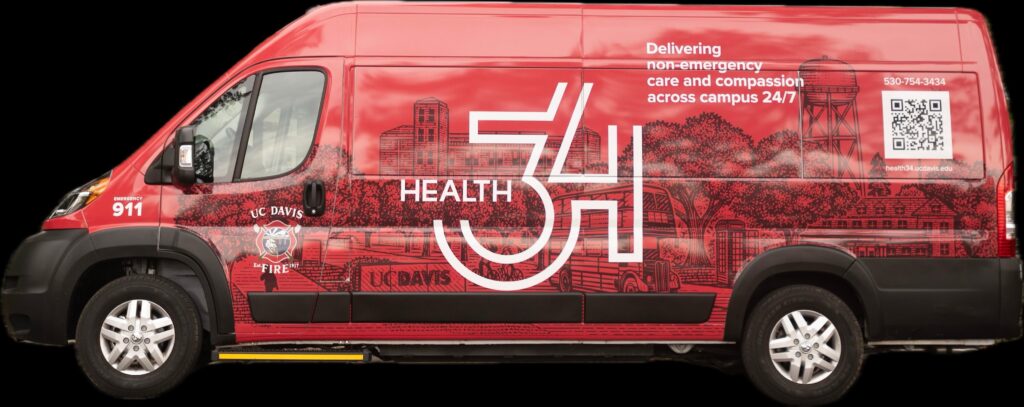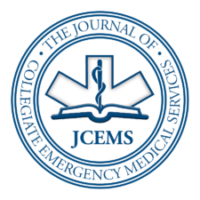| Download PDF (Available Soon) | |
| Author and Article Information |

Background
In 2023, the University of California Davis Fire Department (UCDFD) developed a unique service to create wellness in the collegiate campus community through a mobile community response program. This program is called Health34. The vision is to be a model organization through innovative delivery of services that will enhance campus community well-being.
Health34 accomplishes this vision by performing two major services: navigating clients to resources and bridging care until resource acquisition. Health34 provides crisis avoidance through layperson counseling and navigation to resources. The program is a mobile service navigation unit that responds to any person in their time of need. The resource navigation addresses housing, basic needs, mental health, education resources, social support, and transportation. The program serves all members of the campus community, including students, staff, and visitors. It has some foundations in mobile crisis response, but actively engages the community at a point prior to crisis with a novel crisis avoidance model. We are not aware of another mobile campus response program that takes the stance of crisis avoidance.
Health34 is operational twenty-four hours a day, seven days a week, including holidays and weekends. The community accesses Health34 via a 7-digit phone number. Health34 is staffed with a paramedic provider (H34 provider) and an EMT partner. The EMT partner has several roles. The client-facing roles include answering the phone when the provider is not available and guiding clients to resources. Administrative roles include documentation, driving, equipment checks, and restocking.
For Health34, the EMT partner is a member of the UCDFD Student EMT (SEMT) program. The SEMT program consists of UC Davis students who are also licensed EMTs and employed by UCDFD. Prior to the launch of Health34, the SEMT work included event standby, health education, and teaching in the UCDFD AHA training center.
With the launch of Health34, the job scope of the SEMTs increased to include the role of Health34 EMT partner. This scope was novel and required training. The program has been operational for one year. With the anticipation of training another group of SEMTs, the effectiveness of the training protocol was evaluated. This paper will discuss the steps the Fire Department took to train SEMTs to fulfill a role on the Health34 team and critically appraise the effectiveness of the training.
Logistics
The vaccine clinic administered its first vaccine in February 2021. The clinic was open seven days per week from 8:30 AM to 4 PM with a 45-minute midday closure. Vaccinator shifts were broken into 3.5-hour morning shifts and 3.25-hour afternoon shifts. An online shift scheduling program was established for open sign-up.
The clinic required a large space to accommodate the staff and the patient group while maintaining the requisite 6 feet of personal space required for social distancing. The campus was closed for in-person instruction and research beginning in March 2020, leaving the large UCD Activities and Recreation Center ballroom available for the clinic. Parking, usually pay by hour or permit, was made unrestricted and free to all patients during the vaccination clinic.
Training Overview
SEMT training was multifaceted, placing emphasis on crisis de-escalation, safety, resource navigation, and logistical functions. These training sessions were accomplished in a way that reinforced our standard operating guidelines.
The goal of SEMT training was to train skills and standard operating guidelines. In order to train these skills, SEMT training was broken down into three major steps: conceptual presentations, interactive experiential training with a collaborator from another mobile health service, and on the job administrative training under the supervision of the H34 provider.
Conceptual Presentations
The conceptual presentation stage of training was broken into two presentations created by the H34 providers, and a virtual presentation by a collaborator from a mobile crisis unit. The first presentation provided an overview of the program’s goals and mechanics. The objective was for SEMTs to understand the purpose of the program, the need in the community, and the expected delivery method of the services.
The second presentation introduced the SEMTs to the concept of lay counseling support through theoretical foundations. During this presentation, specific implementation strategies were not provided. This is left to later practical stages of training. The focus areas included open-ended questions, asymmetry, empathetic reflection, bias, and other miscellaneous communication strategies. The goal was to enable the SEMT to actively engage with the client in a supportive fashion.
The presentation then introduced SEMTs to the concept of asymmetry under which SEMTs should minimize sharing information about their own personal experiences or thoughts. A key point stressed by the presentation was that this form of communication can be challenging because it differs from standard interpersonal communication. The importance of this intentional communication is to leave space for the client to share their experience without limitation of the perceived boundaries of societal standards. This model enhances the perception of a nonjudgmental space in which to receive support.
Empathic reflection was another strategy the presentation introduced. The goal is to not convey understanding or judgement but, instead, to reflect back the language used by the client while prompting them to further explain their perspective. Empathetic reflection encourages further reflection in a non-judgmental environment. The presentation addressed attitudes and biases, and how, even unconsciously, these attitudes can conflict with empathy, compromising the trust between the client and provider. Strategies to counter bias were introduced.
The third presentation was delivered on a virtual platform. The facilitator was an experienced provider from a mobile crisis unit in a different region that uses similar methods to H34. This training session discussed de-escalation and safety. The presenter drew on experience to help the SEMTs synthesize the theoretical information through case examples and discussion.
In summary, the presentations formed a foundation for the principles of lay counseling and support. The goal of this training stage was to create a conceptual framework to support experiential training.
Experiential Interactive Training
Next, the SEMTs began experiential training. The in-person training environment provided an opportunity for SEMTs to observe a strong implementation of the conceptual training applied by an experienced provider on calls. The SEMTs participated in client interaction in a graduated role. After each call, the provider conducted a debrief which was structured by the provider and intended to explicitly acknowledge the tools employed in the interaction and discuss the foundation for their use. The focus was justification of actions and pertinent feedback on topics, interaction style, and word choice. This training stage also provided the SEMTs with an opportunity to ask questions about the practical aspects of lay counseling and support.
Lastly, the SEMTs completed the University of California standard safety driver training allowing them to operate the Health34 van.
Administrative Tasks
Administrative task training occurred on the job. During the first few shifts that an SEMT had, when the Health34 team was not responding to calls, the H34 provider instructed the SEMT on tasks including note-taking, answering the phone, campus resources, on-shift expectations, and documentation. The H34 provider presented each the ideal interaction flow for a phone call.
The flow begins with getting the caller’s name, and determining if the caller’s request. The SEMT should gather demographics, contact information, and location. Then in consultation with the H34 provider, the client is notified of an estimated arrival time.
Documentation training included the expected data to collect, including student ID number, location of call, chief complaints, resource utilization and service navigation. The role of the SEMT is to collect during a client interaction to allow the H34 provider to focus on the client.
SEMTs were assigned daily maintenance roles. They perform vehicle inspections, cleanings, and restockings. Instructions regarding the checklist and location of supplies for restocking were provided.
Lessons Learned
Overall, the training was successful at conveying the process and vision for H34 and client interaction. That being said, there are some places where the efficacy of the training can improve.
One improvement would be conducting in-person group training. In-person group training would have given the SEMTs the additional opportunity to perform supervised role play to demonstrate skills with phone calls and in person client interactions. The virtual platform was not effective for role play. In person training would also provide the opportunity for feedback and allow repeated attempts.
Video examples of aspirational client interactions would have enhanced the SEMT’s understanding of layperson counseling and support. These videos could be integrated into virtual or asynchronous training.
A further improvement would be to create written standard operating guidelines as reference charts. The high volume of information in the training could not be integrated into practice immediately. To enhance consistent practice and promote retention of key information, documentation of processes and procedures was necessary. This gives the SEMTs the opportunity to familiarize themselves with the information and perform more consistent work.
Conclusion
With the genesis of Health34, the UC Davis Fire Department had to greatly expand the knowledge and skill set of its SEMTs to accommodate the increase in job scope. To do this, it created a multistage training program meant to provide foundations in lay counseling techniques, a knowledge of new Health34 procedures, and an awareness of local resources. This paper has outlined the structure of our training process and detailed some of the lessons we learned undertaking this first-of-its-kind program in the campus community.
Acknowledgements
Special thanks to the Health 34 Team for their dedication and service to our community.
Author & Article Information
Jack Fagan, NREMT, is a Senior Student EMT for the University of California – Davis Fire Department and has been serving in this role since March of 2023. He has been a member of the Health34 team since its inception and organizes Student EMT trainings. In addition to his work at the fire department, he is a 4th-year Cognitive Science Major with a computational emphasis. Lisa Mills, MD is the Medical Director for the University of California – Davis Fire Department since 2018. In this role, she refined the vision for an intrepid mobile community response service and brought this to implementation as Health 34. She continues to oversee and develop the operational guidelines for Health 34.
Author Affiliations: From University of California – Davis Fire Department – in Davis, California (J.F.; L.M.).
Address for Correspondence: Lisa Mills | Email: ldmills@ucdavis.edu
Conflicts of Interest/Funding Sources: By the JCEMS Submission Declaration Form, all authors are required to disclose all potential conflicts of interest and funding sources. By the JCEMS Submission Declaration Form, all authors are required to disclose all potential conflicts of interest and funding sources. All authors declared no conflicts of interest.
Authorship Criteria: By the JCEMS Submission Declaration Form, all authors are required to attest to meeting the four ICMJE.org authorship criteria: (1) Substantial contributions to the conception or design of the work; or the acquisition, analysis, or interpretation of data for the work; AND (2) Drafting the work or revising it critically for important intellectual content; AND (3) Final approval of the version to be published; AND (4) Agreement to be accountable for all aspects of the work in ensuring that questions related to the accuracy or integrity of any part of the work are appropriately investigated and resolved.
Submission History: Received February 18, 2025; accepted for publication April 11, 2025
Published Online: April 22, 2025
Published in Print: Pending
Reviewer Information: In accordance with JCEMS editorial policy, Advice and Practice manuscripts are reviewed by the JCEMS Editorial Board and, as needed, independent reviewers. JCEMS thanks the Editorial Board members and independent reviewers who contributed to the review of this work.
Copyright: © 2025 Fagan & Mills. This is an open-access article distributed under the terms of the Creative Commons Attribution 4.0 International (CC BY 4.0) License, which permits unrestricted use, distribution, and reproduction in any medium, provided the original author and source are credited. The full license is available at: https://creativecommons.org/licenses/by/4.0/
Electronic Link: Pending








